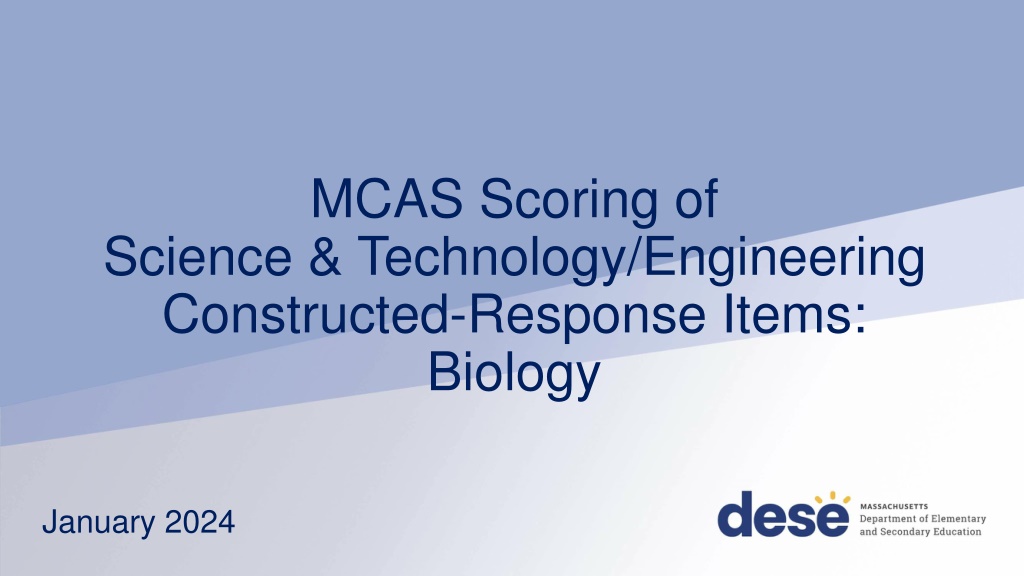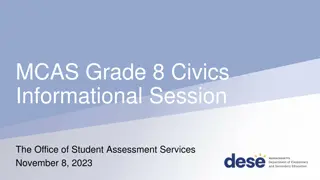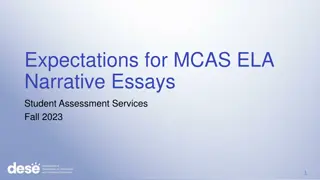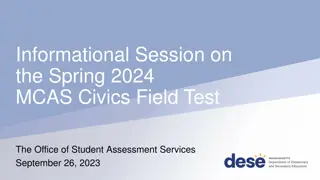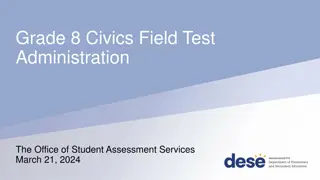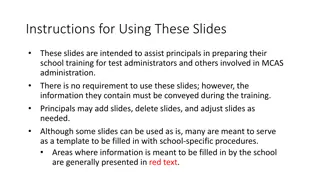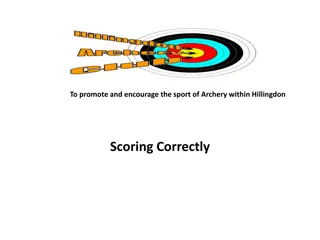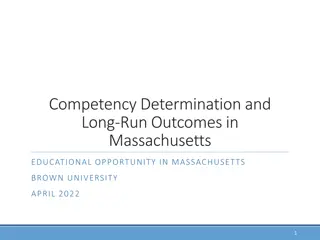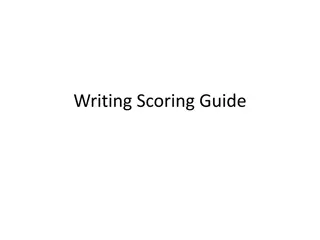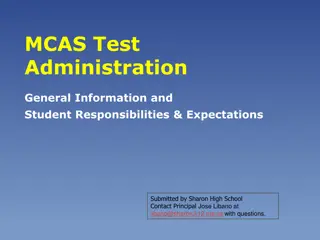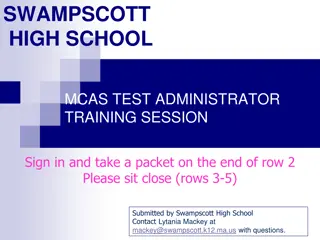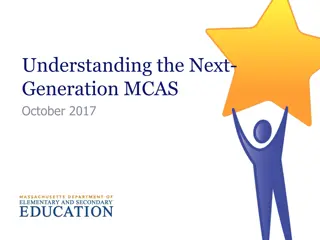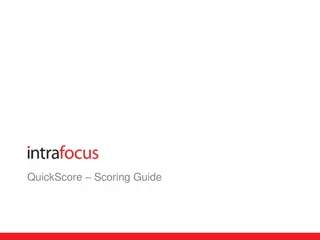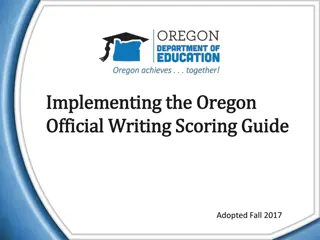MCAS Biology Test Scoring Process Overview
Overview of the MCAS test development and scoring process for High School Biology, focusing on constructed-response items. Students are required to write responses to multi-part questions, which are scored holistically with partial credit. The scoring guidelines emphasize the importance of explaining reasoning, using evidence, and following instructions. The scoring process includes benchmarking, detailed scoring notes, and training packs for scorers. Common errors, such as spelling and grammar mistakes, are not scored on science tests. Full credit is given to students who answer all parts correctly and demonstrate correct content knowledge and practices.
Download Presentation

Please find below an Image/Link to download the presentation.
The content on the website is provided AS IS for your information and personal use only. It may not be sold, licensed, or shared on other websites without obtaining consent from the author.If you encounter any issues during the download, it is possible that the publisher has removed the file from their server.
You are allowed to download the files provided on this website for personal or commercial use, subject to the condition that they are used lawfully. All files are the property of their respective owners.
The content on the website is provided AS IS for your information and personal use only. It may not be sold, licensed, or shared on other websites without obtaining consent from the author.
E N D
Presentation Transcript
MCAS Scoring of Science & Technology/Engineering Constructed-Response Items: Biology January 2024 1
Todays Agenda Overview of MCAS test development and scoring process HS Biology constructed-response (CR) scoring Chicken Combs, Natural Selection CR Plants and Insects Investigation, Photosynthesis & Cellular Respiration CR Review resources available on the Department s website Questions 2 2
Life Cycle of Science and Technology/Engineering (STE) Item 3
Constructed-Response (CR) Questions Students write a response to a multi-part question Scored holistically with partial credit Often ask students to explain their reasoning, use evidence from data, or show their work PBT CBT 4 4
Things Not Scored on Science Tests Spelling, grammar, and punctuation Above grade-level misconceptions Extra or irrelevant information (though caution against this) Using an incorrect calculation from a previous part of an item (typically) 5 5
Full Credit Students who earn full credit: Answer all parts Apply correct content knowledge and practices Follow instructions, such as: Explaining reasoning Analyzing and drawing conclusions based on graphs or data tables Creating or completing scientific models 6 6
Scoring Overview: Benchmarking Review and discuss the scoring of student responses Adjust detailed scoring notes, which include: Correct responses with associated reasoning/calculations How points are assigned Scoring rules for holistic scoring Training packs are put together, which include: 3 anchor papers for each score level 1+ practice papers for each score level 7 7
Scoring Overview: How Responses are Scored Scoring leaders/scorers have content expertise, including college-level courses for the assigned test Before scoring each question, every scorer must: Participate in a detailed training on how to score the responses Satisfactorily score a qualification set made up of actual student responses Embedded responses and read-behinds by scoring leaders are used to monitor a scorer's performance and ensure scoring accuracy All high school responses are scored by two scorers Gr. 5 and 8 Tests: Approximately 25-30% of responses are scored by two scorers 8 8
Constructed Response Scoring Training and Practice 1. Question, score guide, and scoring notes review 2. Anchor papers 3. Individual scoring of student responses 9 9
Biology, Evolution (and Genetics) Question 2023 Chicken Combs 10 10
Question (page 2) The comb on the top of a chicken s head may be full size, intermediate size, or small size. The small-size comb is called a pea comb. A chicken with a pea comb is shown. Part A The allele for a full-size comb (H) and the allele for the pea comb (h) show incomplete dominance. Using allele symbols, identify the genotype of a chicken with a pea comb. Part B Chickens with pea combs have an advantage in cold climates because the pea comb reduces the amount of heat loss the chicken experiences. Describe how the frequencies of the H allele and the h allele are expected to compare in a wild chicken population that lives in a cold climate. Part C Explain how the allele frequencies you described in Part B could be produced as a result of natural selection. 11 11
Item Information Standard Alignment: HS.LS.4.2 Construct an explanation based on evidence that Darwin s theory of evolution by natural selection occurs in a population when the following conditions are met: (a) more offspring are produced than can be supported by the environment, (b) there is heritable variation among individuals, and (c) some of these variations lead to differential fitness among individuals as some individuals are better able to compete for limited resources than others. Practice Category: Evidence, Reasoning, and Modeling Obtaining, Evaluating, and Communicating information Constructing Explanations 12 12
Scoring Guide Score Description The response demonstrates a thorough understanding of inheritance patterns. The response correctly identifies the genotype of a chicken with a pea comb, clearly describes the expected frequencies of the alleles in a chicken population that lives in a cold climate, and clearly explains how these frequencies would be produced as a result of natural selection. 4 The response demonstrates a general understanding of inheritance patterns. 3 The response demonstrates a limited understanding of inheritance patterns. 2 The response demonstrates a minimal understanding of inheritance patterns. 1 The response is incorrect or contains some correct work that is irrelevant to the skill or concept being measured. 0 13 13
Scoring Notes (page 4) Part A (1 point) hh Part B (1 point) The frequency of the h allele should be higher [than the frequency of the H allele]. Part C(2 points) Because chickens with a pea comb (hh) have an advantage/lose less heat in cold environments, they would survive, reproduce, and pass on their genes/traits more frequently than chickens with intermediate or full-size combs. OR Because chickens with intermediate and full size combs (Hh and HH) have a disadvantage/lose more heat in cold environments, they would survive, reproduce, and pass on their genes/traits less frequently than chickens with pea combs. Notes: To receive full credit for Part C response must address (1) the chickens with a pea comb have a survival advantage, and (2) the chickens with pea combs reproduce and pass on their genes/traits to their offspring. For scores of 4, response must explicitly address passing on of genes/traits. At scores of 3 and below, response can simply mention increased rates of survival and reproduction. 14 14
Anchor: Score 4 (page 6) Part A hh Part B Most likely, the h allele will become more frequent in the chicken population because chickens with pea combs have an advantage in cold environments. Part C Since the chickens with pea combs have an advantage over chickens with full size combs, the chickens with pea combs are more likely to survive long enough to reproduce and send their genes onto the next generation. This process is called natural selection, and the end result would be a higher frequency of the h allele. 15 15
Anchor: Score 3 (page 7) Part A hh Part B The h allele will have greater frequency than the H allele in a wild chicken population that lives in a cold climate. Part C The frequency of the h allele would be greater than the frequency of H because h, the allele for the pea comb, is the most favorable in cold climates. Pea combs (hh) reduces the most heat loss compared to the intermediate-sized comb (Hh) and the full-sized comb (HH). Those chickens with the h allele would be better suited to the cold environment and survive compared to those chickens with the H allele. 16 16
Anchor: Score 2 (page 8) Part A hh Part B In a cold climate the frequency of the h allele would be much higher than the H allele, because the h allele gives off less heat & keeps the chicken warmer Part C The frequency of the h allele being more could be produced as a result from natural selection because it keeps the bird warmer and uses less energy, so over time the h allele became more popular through natural selection. 17 17
Anchor: Score 1 (page 9) Part A hh Part B In a cold climate wild chickens will have a pea comb. this helps reduce the amount of heat loss. Part C The chickens in a cold climate would have pea combs because it helps them reduce the amount of heat loss. This is natural selection because the chickens know their pea comb will protect them. 18 18
Anchor: Score 0 (page 10) Part A Hh, hh Part B The chickens without pea combs will decrease because they will get cold, get sick and die. Part C It s because the population will change in the chickens. 19 19
Individual Scoring of Student Responses Use scoring notes and anchor papers to score the student responses in the pack emailed to you. We are also putting a link in the chat. Responses are from actual students but were retyped to be able to more easily see the responses Enter the scores you give each response into the poll. We will discuss the scores as a group. 20 20
Response A (page 12) Part A hh Part B The h allele is going to be more frequent than the H allele. This is because many of the chicken will adjust to the pea comb and produce offspring with the pea comb so as to prevent loss of heat during the cold climate. Part C The h allele will be more frequent than the H allele as a result of natural selection. This is because due to the cold climate the chicken will adjust by developing a pea comb so as to reduce loss of heat. 21 21
Response B (page 13) Part A hh Part B The frequency of the H allele will be far less than the frequency of the h allele in a chicken population that lives in a cold climate. Part C This would occur because the pea combed chicken with the h allele would have an advantage over the full sized comb chickens with an H allele. Pea combed chickens wouldn t use as much energy as long combed chickens, allowing for a much higher rate of survival. Natural selection dictates that pea combed chickens would live on and produce more offspring, passing on their genes. 22 22
Response C (page 14) Part A hh Part B There will be more pea combed chickens, because of the reduced heat loss. Part C It could be part of natural selection because the weather would be the one controlling the pea comb and full size comb populations. 23 23
Response D (page 15) Part A hh Part B The frequency of the H allele would be less than the frequency of the h allele in a wild chicken population that lives in a cold climate. Part C The h allele would be more frequent because the chickens with the H allele would be less likely to survive because of the great amount of heat loss. The chickens with the h allele would be more likely to survive. Over time the wild chickens would have the h allele because of natural selection. 24 24
Response E (page 16) Part A hh Part B The h allele is more expected to be frequent because this allele helps the chicken more form the cold weather that the H allele would. Part C This allele could be produced as a result of natural selection because over time the chicken would want to adapt to their environment and the h allele is more helpful than the H allele. 25 25
Biology, Molecules to Organisms Question 2023 Plants and Insects Investigation 26 26
Question (page 18) A student is studying how flowering plants and insects affect oxygen (O2) and carbon dioxide (CO2) concentrations in the air. Part A Identify the cellular process performed only by the flowering plants that affects the concentration of O2 and CO2 in the air. Part B Identify the cellular process performed by both the flowering plants and the insects that affects the concentration of O2 and CO2 in the air. Part C During an experiment, the student measured the initial concentrations of O2and CO2in three flasks, added organisms to some of the flasks, sealed the flasks, and placed them under a light. After 12 hours, the student measured the concentrations of O2and CO2in the flasks. The results for each flask are shown in the table. During the experiment, the student had forgotten to identify the contents of each flask. Each of the three flasks contained one of the following: two plants and one insect; one insect; or no organisms. Identify the contents of each flask based on the data in rows 1, 2, and 3. Explain your reasoning using data from the table and the processes you identified in Parts A and B. Include the row numbers in your response. 27 27
Item Information Standard Alignment: HS.LS.1.5 Use a model to illustrate how photosynthesis uses light energy to transform water and carbon dioxide into oxygen and chemical energy stored in the bonds of sugars and other carbohydrates. Practice Category: Mathematics and Data Analyzing and Interpreting Data Using Mathematical and Computational Thinking 28 28
Scoring Guide Score Description The response demonstrates a thorough understanding of photosynthesis and cellular respiration. The response correctly identifies the cellular process only the flowering plants perform and also correctly identifies the cellular process that both the flowering plants and insects perform. The response correctly identifies the contents of each flask and clearly explains the reasoning. 4 The response demonstrates a general understanding of photosynthesis and cellular respiration. 3 The response demonstrates a limited understanding of photosynthesis and cellular respiration. 2 The response demonstrates a minimal understanding of photosynthesis and cellular respiration. 1 The response is incorrect or contains some correct work that is irrelevant to the skill or concept being measured. 0 29 29
Scoring Notes (page 19) Part A (1 point) photosynthesis Part B (1 point)cellular respiration/respiration Part C (3 points) 1 pt. for each ID & explanation pair Row Contents Explanation 1 no organisms little/no change in gas concentrations 2 one insect insect performs [cellular] respiration, so O2 decreased and CO2 increased plants perform photosynthesis, so O2 increased and CO2 decreased 3 two plants and one insect Notes: 5 pts = 4 score; 4 pts = 3 score; 2-3 pts = 2 score; 1 pt = 1 score For a score of 4, must use data from the table and include cellular processes in response. At scores of 3 and below, if Parts A and B are correct, accept response to Part C that does not include processes in the explanation. At scores of 2 and below, 3 IDs in Part C with no explanation is acceptable. 30 30
Anchor: Score 4 (page 21) Part A The flowering plants use photosynthesis which affects the CO2 and O2 concentrations. Part B Cellular respiration affects the CO2 and O2 concentration levels Part C Row 1 had no organisms in the flask because the O2 and CO2 levels had little change in concentration. Row 2 had one insect because the oxygen levels decreased but the CO2 levels increased due to cellular respiration. Row 3 had two plants and one insect because the O2 levels increased as there was more oxygen being made than used and the CO2 levels decreased due to photosynthesis. 31 31
Anchor: Score 3 (page 22) Part A The process of the flowering plants that affects the levels of O2 and CO2 in the air is photosynthesis. Part B The process performed by both the flowering plants and insects that affects the concentration of O2 and CO2 in the air is cellular respiration. Part C The contents of flask one was no organisms because the oxygen levels did not change at all. The contents of flask two was one insects because the oxygen levels went down and the carbon dioxide levels went up considerably. The contents of flask three was two plants and one insect because the oxygen levels went up slightly and the carbon dioxide levels went down significantly. 32 32
Anchor: Score 2 (page 23) Part A The cellular process performed only by the flowering plants that affects the concentrations of O2 and CO2 in the air is called photosynthesis. Part B The cellular process performed by both the flowering plants and insects is called cellular respiration. Part C There were two plants and one insect in each flask. The data table shows that there is oxygen and carbon dioxide being produced. The plants produce the oxygen and the insect produces carbon dioxide. If there was one insect or no organisms in each then there would be little to none carbon dioxide and oxygen. 33 33
Anchor: Score 1 (page 24) Part A The cellular process performed would be photosynthesis Part B The cellular process performed would also be photosynthesis Part C Row one = one insect because the final concentration is not the highest Row two = two plants and one insect because the final concentration is the highest on the chart Row three = no organisms because it has the lowest final concentration 34 34
Anchor: Score 0 (page 25) Part A cellular respiration Part B photosynthesis Part C Row one - one insect Row two - two plants and one insect Row three - no organisms 35 35
Individual Scoring of Student Responses Use scoring notes and anchor papers to score the student responses in the pack emailed to you. We are also putting a link in the chat. Responses are from actual students but were retyped to be able to more easily see the responses Enter the scores you give each response into the poll. We will discuss the scores as a group. 36 36
Response A (page 27) Part A The cellular process performed only be the flowering plants that affects the concentrations of O2 and CO2 in the air is photosynthesis. Part B The cellular process performed by both the flowering plants and the insects that affects the concentrations of O2 and CO2 in the air would be cellular respiration. Part C Row one - no organisms, Row two - one insect, Row three - two plants and one insect. 37 37
Response B (page 28) Part A Photosynthesis is the cellular process performed only by flowering plants that affects the concentrations of O2 and CO2 in the air. Part B Cellular respiration is performed by both the flowering plants and the insects that affects the concentrations of O2 and CO2 in the air. Part C In row 1, there are no organisms in the flask because there is no effect to the amount of oxygen in the flask, and CO2 only went up by 2 ppm. In row 2, there is one insect because oxygen levels reduced and CO2 level drastically increased. In row 3, there are two plants and an insect because oxygen levels rose and CO2 levels dropped due to photosynthesis from the plants. 38 38
Response C (page 29) Part A The cellular process performed only by the flowering plants that affects the concentrations of O2 and CO2 in the air is photosynthesis. Part B The cellular process performed by both the flowering plants and the insects that affects the concentrations of O2 and CO2 in the air is cellular respiration. Part C In row 1 there is no organisms. I know that because it is showing no oxygen, but organisms need oxygen to survive. In row 2 there is only an insect. I know that because there is a drop in oxygen meaning some of it was used. And finally in row 3 is the insect and the two plants. I know that because the CO2 is less and that is what the plant uses. 39 39
Response D (page 30) Part A Only the flowering plants perform photosynthesis in order to produce food for themselves. Part B Both the flowering plants and the insects perform cellular respiration to turn their food into energy (glucose into ATP). Part C Flask 1 contains no organisms because the gas levels are stable, Flask 2 contains one insect because the O2 level decreased while the CO2 level increased (cellular respiration), and Flask 3 contains two plants and one insect because the O2 level increased while the CO2 level decreased (photosynthesis). 40 40
Response E (page 31) Part A carbon dioxide Part B hydrogen oxide Part C Row one: no organism Row two: one insect Row three: 2 plants 1 insect 41 41
Resources on DESE Website Resource Link MCAS headlines and links https://www.doe.mass.edu/mcas/ STE Test Development & Design https://www.doe.mass.edu/mcas/tdd/sci.html Student Work Samples https://www.doe.mass.edu/mcas/student/default.html Released Questions Practice Tests and Tutorial http://mcas.pearsonsupport.com/released-items/science/ http://mcas.pearsonsupport.com/student/ MCAS Training Page https://www.doe.mass.edu/mcas/training.html 42 42
Contact Information DESE Office of Student Assessment for policy questions (e.g., test designs, accommodations) Web: www.doe.mass.edu/mcas Email: mcas@doe.mass.edu Phone: 781-338-3625 MCAS Service Center Web: http://mcasservicecenter.com/ Phone: 1-800-737-5103 43 43
THANK YOU 44 44
